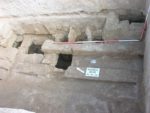 Archaeologists excavating the site of an ancient city on the shore of Lake Mariout southwest of Alexandria have unearthed a stone latrine in the remains of a Byzantine-era basilica. Built in the late 5th century A.D., the basilica was the second largest of its kind in Egypt. During its heyday, masses were attended by huge crowds. Congregants filled the interior and pilgrims lined the exterior of the church. Hence the need for toilet facilities.
Archaeologists excavating the site of an ancient city on the shore of Lake Mariout southwest of Alexandria have unearthed a stone latrine in the remains of a Byzantine-era basilica. Built in the late 5th century A.D., the basilica was the second largest of its kind in Egypt. During its heyday, masses were attended by huge crowds. Congregants filled the interior and pilgrims lined the exterior of the church. Hence the need for toilet facilities.
“We believe that they were available to the believers – from the inside of the basilica, and to the pilgrims – from the outer walls of the building” – said [excavation director Dr. Krzysztof] Babraj. According to the scientist, the discovery is not a surprise for researchers, because the latrines were a standard facility in ancient churches. There probably were separate rooms for women and separate for men.
“Interestingly, the priest had a private latrine in one of the side chapels of the basilica” – added the archaeologist.
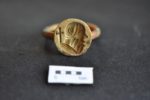 In keeping with the fine tradition of important artifacts being found in and around toilets, the team has discovered two exceptional pieces of jewelry in the rooms next to the latrines: a bronze seal ring engraved with the figure of a saint, and a tiny bracelet (probably worn by a child) engraved with an apotropaic symbol to ward off evil and bad luck. The seal ring is the only one known to have
In keeping with the fine tradition of important artifacts being found in and around toilets, the team has discovered two exceptional pieces of jewelry in the rooms next to the latrines: a bronze seal ring engraved with the figure of a saint, and a tiny bracelet (probably worn by a child) engraved with an apotropaic symbol to ward off evil and bad luck. The seal ring is the only one known to have 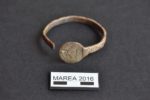 been discovered in northern Egypt. Researchers think it is a bishop’s ring used to stamp the official’s seal on official documents and correspondence.
been discovered in northern Egypt. Researchers think it is a bishop’s ring used to stamp the official’s seal on official documents and correspondence.
The Polish Centre of Mediterranean Archaeology, University of Warsaw and the Archaeological Museum of Krakow have been excavating the site since 2000. They believe it is the ancient city of Marea, a port town that gained international fame in the Greco-Roman era for its high quality wine, glass and pottery. Marea’s proximity to the Nile at full flood and to the Mediterranean enabled it to create a direct navigable route to the sea via a series of canals. The city prospered from the Mediterranean and Upper Egyptian trade for centuries and a great deal of archaeological evidence attests to the importance of its port. Six massive stone piers more than 100 meters (330 feet) long have been unearthed, the largest of which was made from large stone blocks sealed with waterproof mortar. Archaeologists have also found quays, a causeway linking the port an island 100 meters east on which additional piers and quays were built. There were sufficient harbour facilities to allow hundreds of ships to load and unload cargo at the same time.
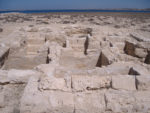 While the Polish mission calls the site Marea, there is not universal agreement among scholars that they’re right. Marea was an important city already in the early Roman and was likely already coming to prominence during the reign of the Ptolemies, but in almost two decades of excavation, the mission has found very few remains from the Greco-Roman period, most notably a kiln from the 2nd-3rd century A.D. which is one of the largest ever found in Egypt. The basilica, public baths, and massive stone piers, the kind of imposing structures you would expect a city like Marea to have had in its ancient heyday, all date to much later, the 5th and 6th centuries.
While the Polish mission calls the site Marea, there is not universal agreement among scholars that they’re right. Marea was an important city already in the early Roman and was likely already coming to prominence during the reign of the Ptolemies, but in almost two decades of excavation, the mission has found very few remains from the Greco-Roman period, most notably a kiln from the 2nd-3rd century A.D. which is one of the largest ever found in Egypt. The basilica, public baths, and massive stone piers, the kind of imposing structures you would expect a city like Marea to have had in its ancient heyday, all date to much later, the 5th and 6th centuries.
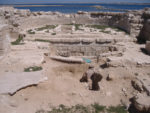 Another possible identification for the city has been posited by the University of Warsaw’s Mieczyslaw Rodziewicz, an expert in Greco-Roman Alexandria. He suggested it might be Philoxenite, a Byzantine city founded during the reign of Eastern Roman Emperor Anastasius (491-518) to provide shelter and supplies for pilgrims on their way to the monastery of Abu Mena less than 20 miles southeast of the city. The body of martyr and saint Menas of Alexandria was said to have been transported from Alexandria past Lake Mariout into the desert. The monastery was built on the spot of his burial. It makes sense that a city built to accommodate pilgrims on their way to Abu Mena would be located on the path his body took, that it would have the large-scale facilities necessary to host this kind of traffic and that they would date to the early Byzantine era.
Another possible identification for the city has been posited by the University of Warsaw’s Mieczyslaw Rodziewicz, an expert in Greco-Roman Alexandria. He suggested it might be Philoxenite, a Byzantine city founded during the reign of Eastern Roman Emperor Anastasius (491-518) to provide shelter and supplies for pilgrims on their way to the monastery of Abu Mena less than 20 miles southeast of the city. The body of martyr and saint Menas of Alexandria was said to have been transported from Alexandria past Lake Mariout into the desert. The monastery was built on the spot of his burial. It makes sense that a city built to accommodate pilgrims on their way to Abu Mena would be located on the path his body took, that it would have the large-scale facilities necessary to host this kind of traffic and that they would date to the early Byzantine era.
There’s a chance we might find the answer to this question written on potsherds. In a group of commercial buildings and residences behind the apse of the basilica, the Polish mission found a large number of ostracons (pottery fragments with writing scratched onto them). These are records left behind by the workers who built the basilica. They date to the 5th-6th century and most of them appear to have been written by one man. Translation is ongoing.
I’m familiar with the idea of food taboos for that part of the world. Were there poo taboos? I don’t remember any mention at Sunday school. But if one is being anal-obsessive about food, why not poo?
Dearie, myself I am not really familiar with Byzantine nor Northern African ‘taboos’, but when it comes to trafficking ‘substances’ and ‘humans’, there probably have never :skull: been any:
==============
Mare(i)a (Μάρεια) was -according to Strabon- famous for its wine making facilities, not necessarily for its latrines.
Contrastingly, ‘Philoxenite‘ (φιλοξενίτη) in its Latin form –(literally ‘loving guests’)– sounds like some form of ‘product name’, and indeed it seems to be a mineral (with quite a few elements). According to the Intern. Mineralogical Association, IMA2015-108, “Philoxenite”: (K,Na,Pb)_4 (Na,Ca)_2 (Mg,Cu)_3 (Fe^3+ _0.5 Al_0.5) (SO4)_8
==============
Confusingly, there is -in addition to all this- ‘Bacchides’, a play by (the Roman playwright) Plautus:
“Two friends on a business trip to Ephesos, Mnesilochus, a young Athenian, and Pistoclerus, have fallen in love with -actually two– prostitutes named Bacchis. Mnesilochus’s Bacchis (from Samos) has been hired for a full year by the soldier Cleomachus. In order to get the money to buy her release, Mnesilochus asks Chrysalus, a clever slave, to extort money from Mnesilochus’ father Nicobulus.
Chrysalus succeeds, but then Mnesilochus witnesses a conversation between Lydus, the teacher of his buddy Pistoclerus, und his father Philoxenus: Lydus is upset about the deals between a certain courtesan ‘Bacchis’ and Pistoclerus. Then, Pistoclerus announces his love for ‘Bacchis’. Mnesilochus, not aware that there is more than one Bacchis, and the other one is from Athens, hands back the money to Nicobulus and reveals the whole deception and Chrysalus’s part in it.
Then, the truth comes out – There are two Bacchises, and Pistoclerus loves the other Bacchis! – In despair, Mnesilochus returns to Chrysalus and begs him to try to get money from Nicobulus again. Chrysalus agrees and tricks Nicobulus out of his money by informing him -in a ‘* Bellerophon letter’ (!)- that Mnesilochus is in trouble because he has fallen in love with a soldier’s wife. He claims that the only way to get Mnesilochus out of trouble is to pay the soldier. Nicobulus falls for the trick and gives over the money.
Soon, Nicobulus finds out that he has been deceived, and with Philoxenus he storms the brothel. Nicobulus demands his son and gold back. Bacchis offers the old man half of his gold back if he comes in. Philoxenus and Nicobulus soon give into Bacchis and her sister.
… They both enter the brothel.” :confused:
—-
(*) regarding ‘Bellerophon’, cf. the post from September 1st, 2017